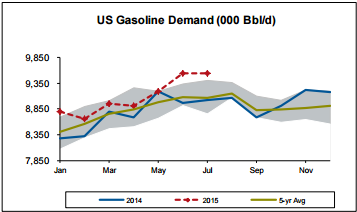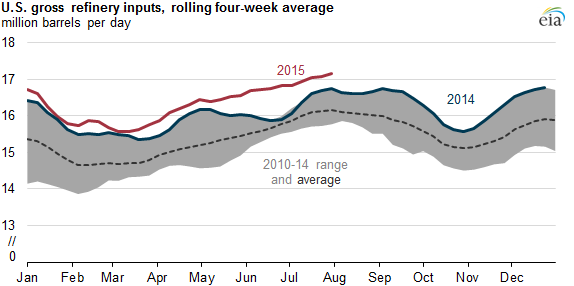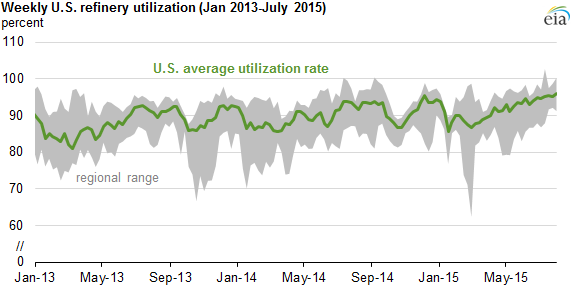The rolling four-week average of refinery inputs exceed the five-year average every week this year
Gross inputs to U.S. refineries exceed 17 million barrels per day (MMBOPD) in each of the past four weeks, the highest level of refinery inputs seen by the Energy Information Administration (EIA) since the organization began publishing weekly data in 1990. Inputs have been above the previous five-year range (2010-2014) every week so far this year.
These record high levels are a reflection of both higher refinery capacity and higher utilization rates, according to the EIA. Lower crude oil prices and strong demand for petroleum products, especially gasoline, have led to favorable margins. The gasoline crack spread reached a peak of $0.66 per gallon on July 8, a level not seen since September 2008.

Higher demand for gasoline is also supporting stronger margins compared to distillate. In the past, distillate crack spreads have consistently exceeded those for gasoline, but in May, this trend reversed. From 2011 to 2014, distillate crack spreads averaged a $0.24/gal premium over gasoline. Since May 20, Gulf Coast gasoline crack spreads have averaged $0.17/gal higher than for distillate crack spreads.
Total U.S. motor gasoline product supplied is up 2.9% through the first five months of 2015, and trade press reports indicate that demand is also higher in major world markets such as Europe and India so far this year compared with 2014. Total U.S. petroleum product supplied is up 2.5% through the first five months of the year compared with 2014. Much of the refinery output is reaching global markets, as net exports are 19% higher this year through May.
Favorable margins have been driving utilization rates to record high levels across the country. Despite the ongoing unplanned outage at ExxonMobil’s (ticker: XOM) refinery in Torrance, California, utilization on the West Coast exceeded 90% for the past three weeks, marking the second, third and fourth times that all five regions have recorded refinery utilization rates above 90% within the same week since EIA began publishing weekly utilization data in 2010.
Refinery runs tend to be highest in the second and third quarters of the year when demand for gasoline is at its highest. The EIA expects refinery inputs to decline through the end of the year, bottoming out at about 15.8 MMBOPD in the first quarter of 2016, before increasing through next summer to even higher levels. The EIA’s Short-Term Energy Outlook (STEO) predicts that U.S. refinery runs will be even higher next summer, averaging 16.9 MMBOPD in the third quarter of 2016.









